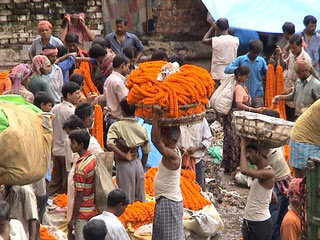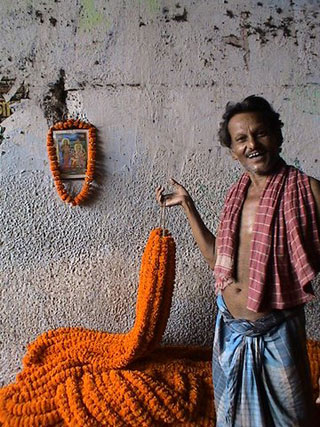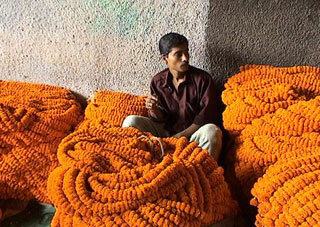Human Flower Project
Marigolds of Mullickghat
Below the Hoogly River bridge, gold shines through Kolkata’s flower market.

At the busy Mullickghat flower market
Kolkata (Calcutta), India, Summer 2006
All photos: Sandy Ao
The authorities have authorized and planners planned before. Now, could it really be that Kolkata’s age-old flower market will come indoors?
Our friend photographer Sandy Ao sent a bounty of photographs from Mullickghat, as the wholesale market’s known. Since she took these shots last summer, there’s been yet another declaration of development
“The decaying wholesale flower market at Mullickghat, under Howrah bridge, is finally set to be replaced by a five-storeyed market complex, which will also be India’s first international flower auction centre.” As one would guess, expectations are pie-in-sky high: A piece in The Statesman predicted that with the new “flower mall…. Bengal can only expect the flower market to grow by leaps and bounds in the days to come.”
We’ve found similar stories in the Indian papers dating back to 2001 and 2002, when apparently the government took over the old market. (Meanwhile, chemical engineers at Jadavpur University are racing for ways to recycle the market’s loads of unsold flowers, turning them into soda pop, candles, and insect repellant.)
It all reminds us a bit of the fairy tale king who tried commanding the ocean waves. Our sense is that Mullickghat is a force of nature. Can it be corralled into a “five-story complex”?
Take a look at some of Sandy’s photos. And hear what she has to say.

“Mullickghat remains the same everyday – an ageless place! It is as if times stands still in the marketplace.
“Many types of flowers are sold here – during the Durga Puja period around end September – October, lotuses are the main variety, but the Marigold has a permanent place in the sales.
“You asked me about why people love Marigold. Well, I am fortunate to have a lawyer neighbour to enlighten me about your question. Firstly, the Marigold (its name in Hindi is “Genda”—pronouced “Kanda”) is loved for its colour. In India, the yellow colour signifies Joy and the season Spring. In other words, it represents happiness and life.
“The second reason is economics. Offering flowers is a must during Puja (the ritual paying homage to the Gods and Goddess). Every single flower offered to the deity gains a single value of blessing. For instance if one is to gain 10 blessings, one has to offer (and to buy) 10 single flowers. But if one offers a single Marigold flower during “Puja”, one can receive a blessing equivalent to 10 flowers. That’s because each Marigold flower contains more than 10 single complete flowers in itself! So, it becomes affordable to gain as much blessing with the cost of one single Marigold.
“Each long garland of Marigold has about forty or fifty flowers and sells here for Rs. 3-10 (approximately 7-23 cents, US currency). In the retail market, each string can cost from Rs.5 to Rs.20 (12-45 cents) or more, depending on the occasion or season. Smaller garlands of Marigold, with about ten flowers, may cost as little as 1 R. (2 cents).
 “These strings of Marigold are used for decorating the temple, garlanding the God /Goddess at home or in the temple, and blessing a marriage hall or home. The marigold strings also bless new places of business, shops, cars, buses, even bicycles. Family members put marigold garlands around the photos of their beloved dead (I do that on my late father’s picture too!) When we see a garland put around any portrait, we know that person is no more.
“These strings of Marigold are used for decorating the temple, garlanding the God /Goddess at home or in the temple, and blessing a marriage hall or home. The marigold strings also bless new places of business, shops, cars, buses, even bicycles. Family members put marigold garlands around the photos of their beloved dead (I do that on my late father’s picture too!) When we see a garland put around any portrait, we know that person is no more.
“And not forgetting the most important thing…. the marigold garlands are used for welcoming the politicians too!! Some such garlands can be awfully huge! Sounds amazing isn’t it?! Everyone loves Marigold!
“Marigold also thrives very well in this rich alluvial soil in Calcutta. Around this particular flower market, many farmers grow nothing else for their livelihood. It’s cultivated like any other crop.
“The market is located under the historical Howrah Bridge. It is on the banks of the Hoogly River, the supply point to all the flowers shops in Calcutta. Some merchants will collect the supplies here and wait in one big hall for the next ferry to take them to the other districts and states of India.
“It’s a very, very old market, so many people depend on it for their livelihood. Though it may be dirty and crowded, everyone loves to pay a visit here even if one does not buy a single flower.”

So what of the latest plan to demolish Mullickghat, what there is of it, and replace the vibrant outdoor market with a climate-controlled building?
Sandy writes, “The government was suggesting to move this market. That seems very unlikely as the location of this market is the ideal place for the farmers to deliver their harvest and also the right place for the merchants to transport the goods through boat or rail. We have an equally old train terminal—Howrah Railway Station—on the other side of the bridge.”
Something about the darkness and age of these surroundings intensifies the light inside the flowers. The marigolds especially are dazzling, tufts and ropes and hills of sweet electricity. Thank you so much for enlightening us, .(JavaScript must be enabled to view this email address)!


Good info. We do walks and city tours in Calcutta and really appreciate that someone realises the tourism potential of our city.